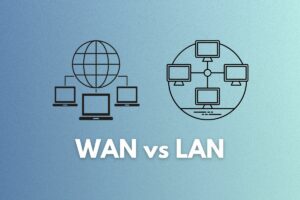What is WiFi 6 (802.11ax)? Understand and Upgrade Your Network
We’re reader-supported; we may earn a commission from links in this article.
Are you struggling with slow internet speeds and network congestion? Welcome to the world of WiFi 6, the latest wireless standard designed to revolutionize your online experience.
In this article, you’ll learn about the cutting-edge features of WiFi 6, its compatibility with your existing devices, and the future of wireless technology.
But first, let’s answer the question: what is WiFi 6? Say goodbye to buffering videos and hello to seamless streaming!
Short Summary
- WiFi 6 (802.11ax) is the latest wireless standard, bringing faster speeds and increased efficiency for modern homes and offices.
- Features such as 1024-QAM, OFDM symbol & channel width expansion, BSS Color reduction of interference, Target Wake Time power saving & WPA3 encryption are included in WiFi 6 networks.
- Upgrading to WiFi 6 offers numerous benefits. Compatibility must be taken into consideration before upgrading your network.
Unveiling WiFi 6: The Latest Wireless Standard
WiFi 6, also known as 802.11ax, is a game-changer in the world of wireless connectivity.
Released in 2019, it boasts significant improvements over its predecessors, such as faster speeds, increased efficiency, and enhanced support for multiple devices in high-demand scenarios.
This is particularly beneficial for households with a large number of devices, like smartphones, laptops, game consoles, and smart home devices, which can cause network congestion and slow down your internet experience.
The Wi-Fi Alliance, responsible for developing Wi-Fi standards, introduced several new features in WiFi 6 to accommodate the rising demand for wireless connectivity in modern homes and offices. These features, compared to earlier wi fi standards, include:
- 8×8 uplink/downlink
- MU-MIMO
- OFDMA
- BSS Color capabilities
These capabilities allow for up to 4x larger capacity and improved handling of client devices, ultimately reducing network congestion for multiple users.
A New Era of Wireless Connectivity
WiFi 6 ushers in a new era of wireless connectivity by offering increased data rates, greater network capacity, improved performance in dense environments, and enhanced power management.
These enhancements are made possible through technologies like 1024-QAM, expanded OFDM symbol, and channel width, OFDMA, and MU-MIMO.
As a result, WiFi 6 can deliver smoother streaming experiences, faster downloads, and more responsive smart home devices.
Moreover, WiFi 6 introduces features like:
- BSS Color and Reduced Interference to improve performance when multiple devices are connected to the same network
- Power-saving features like Target Wake Time
- Enhanced security measures with WPA3 encryption
These make WiFi 6 an attractive upgrade for both individual users and businesses.
From 802.11ax to WiFi 6
The technical standard for the next generation of WiFi, 802.11ax, was rebranded as WiFi 6 to simplify the naming convention for consumers.
This new wireless standard operates in both the 2.4GHz and 5GHz ranges, creating more available channels for enhanced performance.
WiFi 6 offers increased throughput speeds, enhanced battery life, and reduced bandwidth congestion compared to earlier WiFi standards, making it a superior choice for modern Wi-Fi devices.
However, to truly take advantage of the increased performance and features of WiFi 6, it’s essential to upgrade your devices to support this new standard.
While WiFi 6 is backward compatible with previous WiFi standards, upgrading your network equipment enables you to experience the full benefits of this cutting-edge technology.
Speed and Efficiency Upgrades
One of the most notable advancements of WiFi 6 is its speed and efficiency upgrades.
These upgrades are made possible through the incorporation of 1024-QAM for faster raw speeds and expanded OFDM symbol and channel width for increased coverage and speed.
As a result, WiFi 6 can handle more data simultaneously, making it a perfect choice for households and businesses with multiple connected devices and high bandwidth demands.
These enhancements not only improve the overall performance of your Wi-Fi network, but also provide a more reliable and consistent experience for all users.
Whether you’re streaming 4K videos, playing online games, or participating in video conferences, WiFi 6 ensures that your network can easily handle the load.
Boosted with 1024-QAM
1024-QAM, or 1024-Quadrature Amplitude Modulation, is a key feature of WiFi 6 that enables higher data rates and improved efficiency in high density scenarios.
By transmitting more data per symbol, 1024-QAM enhances WiFi 6 speeds by 25% compared to 256-QAM, resulting in a smoother streaming experience.
With the increased speeds offered by 1024-QAM, users can enjoy faster downloads, seamless video streaming, and improved performance in crowded networks. This makes WiFi 6 an ideal choice for both residential and commercial settings where high-speed internet access is crucial.
Expanded OFDM Symbol and Channel Width
WiFi 6 features include:
- Expanded OFDM symbol and channel width, which contribute to enhanced coverage and increased speed for your wifi router
- 4x longer OFDM symbol, improving coverage and speed by 11%
- Expanded channel width, enabling faster connection from the router to the device
- Support for 8K movie streaming, large file downloads and uploads, and responsive smart home devices without buffering
This increased coverage and speed enable WiFi 6 networks to better accommodate the growing number of connected devices in modern homes and offices. As a result, users can enjoy a more seamless and reliable wireless experience, even in crowded and dense environments.
Enhanced Multi-Device Support
One of the most significant challenges faced by modern wireless networks is the increased demand for simultaneous multi-device support.
With the rise of smart home devices, IoT gadgets, and the need for high-speed internet access, networks must be able to efficiently handle the traffic generated by multiple devices without compromising performance.
WiFi 6 addresses this challenge by introducing technologies like OFDMA and MU-MIMO, which enable efficient data delivery to multiple devices at once, improving both upload and download speeds.
These enhancements not only provide a better user experience for individual devices, but also improve the overall performance of the network.
WiFi 6 optimizes traffic across these devices and ensures a consistent, high-speed connection for all users by enabling seamless communication with multiple devices that require data simultaneously.
OFDMA and MU-MIMO
OFDMA and MU-MIMO are crucial technologies that simultaneously facilitate efficient data delivery to multiple devices.
OFDMA, or Orthogonal Frequency Division Multiple Access, allows for concurrent data delivery to multiple devices, reducing the time to send and receive data and consequently improving upload and download speeds.
MU-MIMO, or Multi-User Multiple Input Multiple Output, enables a WiFi 6 router to communicate with multiple devices at the same time, further improving the efficiency and capacity of the network.
Together, OFDMA and MU-MIMO offer enhanced network performance, augmented capacity, and extended coverage.
This makes WiFi 6 an ideal solution for households with multiple connected devices and high bandwidth demands.
BSS Color and Reduced Interference
BSS Color is a unique feature of WiFi 6 that helps reduce interference from neighboring networks.
By assigning a distinct color to each Access Point (AP), devices can quickly differentiate between packets from their own AP and those from other networks, avoiding collisions and reducing the number of retransmissions.
As a result, BSS Color offers the following benefits:
- Minimizes interference and improves network performance
- Allows your WiFi 6 router to handle more data with less power consumption
- Leads to a more efficient and high-performing network
- Ensures a seamless online experience for all connected devices.
Power Saving and Security Features
WiFi 6, a significant advancement in wifi technology, introduces advanced power-saving and security features, making it an attractive upgrade for energy efficiency and data protection users.
One such feature is Target Wake Time (TWT), which increases device sleep time and improves battery life for mobile and IoT devices.
In terms of security, WiFi 6 offers WPA3 encryption, providing a higher level of protection for connected devices and safeguarding against potential threats.
These additional features make WiFi 6 a compelling choice for anyone looking to upgrade their wireless network while also prioritizing energy efficiency and security.
Target Wake Time
Target Wake Time, or TWT, is a power-saving feature of WiFi 6 that increases device sleep time to optimize battery life for mobile and IoT devices.
This is particularly beneficial for battery-powered devices like smartphones, tablets, and smart home devices, which require constant connectivity while also conserving energy.
By intelligently managing data streams and allowing devices to sleep for longer periods, TWT not only extends battery life but also reduces power consumption on the network as a whole.
As a result, users can enjoy a more energy-efficient and environmentally friendly wireless experience with WiFi 6.
WPA3 Encryption
WPA3 encryption is a significant security enhancement offered by WiFi 6, ensuring consistent protection for connected devices.
This advanced encryption standard employs Simultaneous Authentication of Equals (SAE) to establish secure key exchanges and provides enhanced security for individual users through stronger encryption algorithms and improved password guessing defenses.
By upgrading to a Wi Fi 6 network, users can enjoy the peace of mind that comes with knowing their data is being transmitted securely, without compromising the speed and efficiency of their wireless connection.
Compatibility and Upgrade Considerations
While WiFi 6 offers numerous advantages over previous wireless standards, it’s essential to consider compatibility and upgrade requirements before making the switch.
WiFi 6 is backward compatible with earlier WiFi standards, allowing existing devices to connect to a WiFi 6 network at their rated speeds.
However, to fully experience the benefits of WiFi 6, it’s necessary to upgrade your router and other network equipment.
In the following sections, we’ll discuss the compatibility of WiFi 6 with previous wireless standards and provide guidance on upgrading your network to ensure a smooth transition.
Backward Compatibility
One of the key advantages of WiFi 6 is its backward compatibility with previous wireless standards.
This means that even if your current devices don’t support WiFi 6, they can still connect to a WiFi 6 network and operate at their rated speeds. As a result, you can gradually upgrade your devices without worrying about compatibility issues.
However, to truly benefit from the increased performance and features of WiFi 6, you’ll need to upgrade your devices to support this new standard.
This may include purchasing a new router, adapter cards, or replacing older devices with newer models that support WiFi 6.
Upgrading Your Network
When upgrading your network to WiFi 6, there are a few steps to consider.
- Purchase a compatible WiFi 6 wireless router or adapter card.
- Ensure that the necessary software drivers for your WiFi 6 devices are installed.
- Replace your current router or install the WiFi 6 adapter card in your PC.
By taking these steps, you’ll be well on your way to enjoying the numerous benefits of WiFi 6, including faster speeds, improved efficiency, and enhanced security. Upgrading your network may seem like a daunting task, but the long-term benefits of WiFi 6 make it a worthwhile investment.
The Future of WiFi: Introducing WiFi 6E
WiFi 6E is the future of wireless technology, utilizing the 6GHz bandwidth for even faster speeds and lower latency.
This cutting-edge technology provides enhanced performance, reduced latency, and increased capacity when compared to WiFi 6.
However, WiFi 6E is currently expensive and not practical for most users due to the necessity of new hardware and its limited availability.
As more devices come to market and the technology becomes more widely adopted, WiFi 6E will become increasingly accessible and cost-effective.
It is anticipated to become the new norm for wireless technology in the foreseeable future, making it an exciting development to watch out for.
Summary
In conclusion, WiFi 6 is a groundbreaking wireless standard that offers faster speeds, increased efficiency, and enhanced support for multiple devices.
With features like 1024-QAM, expanded OFDM symbol and channel width, OFDMA, MU-MIMO, BSS Color, Target Wake Time, and WPA3 encryption, WiFi 6 is poised to transform the way we experience wireless connectivity.
As technology continues to evolve and the demand for reliable, high-speed internet access grows, WiFi 6 and its successor, WiFi 6E, will play a pivotal role in shaping the future of wireless communication.
Frequently Asked Questions
What is Wi-Fi 6 and do I need it?
Wi-Fi 6 is a high-efficiency wireless communication protocol designed to better manage home networks with multiple smart devices. Most modern routers now support this protocol, so upgrading can help you get the most out of your internet connection.
Is Wi-Fi 6 better than Wi-Fi?
Wi-Fi 6 offers faster speeds, better safety protocols, and increased support for multiple devices than Wi-Fi 5. It is the best choice for those who need higher throughputs and reliable connections, particularly if they have gigabit internet or multiple devices to connect.
With Wi-Fi 6, users can enjoy faster speeds, improved security, and more support for multiple devices. It is ideal for those who need higher throughputs and reliable connections, especially if they have gigs.
What is the downside of Wi-Fi 6?
WiFi 6 is not yet compatible with many devices, and can result in a slower signal than desired when combined with older routers. Additionally, it requires highly linear RF front ends and tight EVM specification to achieve high data rates with 1024-QAM.
How does WiFi 6 improve network performance in crowded environments?
WiFi 6 makes use of advanced technologies such as OFDMA, MU-MIMO and BSS Color to deliver efficient data to multiple devices simultaneously, thus improving performance in crowded environments by reducing interference.
These technologies allow for faster speeds, better reliability, and improved battery life for connected devices.
WiFi 6 is the latest generation of WiFi technology, and it is designed to provide a better user experience in crowded environments.
It is the perfect solution for homes, offices, and public spaces with much space.
What is the difference between WiFi 6 and WiFi 6E?
WiFi 6E is an upgrade to WiFi 6, offering faster speeds and lower latency due to the utilization of the 6GHz bandwidth.
This new technology provides users with a more reliable connection and faster speeds than ever before. It also allows for more devices to be connected to the same network without sacrificing performance. With the addition of the 6GHz bandwidth, users can now access the 6GHz bandwidth.

Justin Chia
Justin is the author of Justjooz and is a data analyst and AI expert. He is also a Nanyang Technological University (NTU) alumni, majoring in Biological Sciences.
He regularly posts AI and analytics content on LinkedIn, and writes a weekly newsletter, The Juicer, on AI, analytics, tech, and personal development.
To unwind, Justin enjoys gaming and reading.







